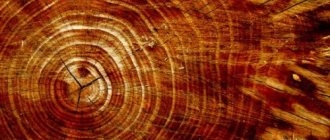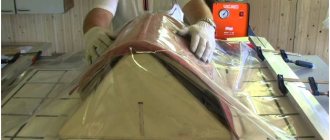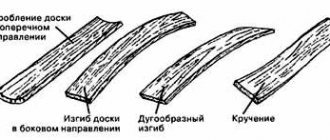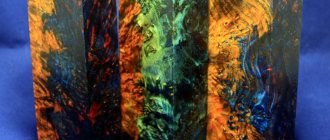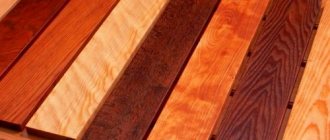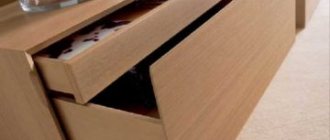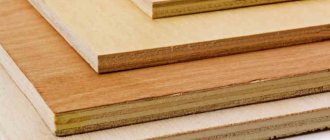Wood is one of the most popular materials for construction. To obtain high-quality and durable buildings, the wood must have a certain degree of moisture. Drying it at woodworking enterprises is carried out using special equipment. But at home, this process is impossible, but drying will only be possible if certain rules and conditions are met.
Drying lumber at home
Materials and tools
For high-quality drying of wood at home, it is arranged under a canopy in a well-ventilated place. Under the influence of atmospheric phenomena, moisture evaporates, and the remainder, which is equal to the humidity of the environment, is distributed evenly throughout the structure.
But this material cannot be called fully dried. Usually the percentage of moisture is higher than permissible because it does not fall below the air humidity. This is especially noticeable in regions with high humidity levels - for example, coastal regions.
For high-quality drying of lumber you will need:
- iron sheets, roofing felt;
- paper;
- beams, pipes;
- glue, paint;
- polyethylene film.
The main disadvantages of self-drying:
- duration in time;
- risk of wood warping;
- the difficulty of bringing humidity levels to 6 - 8%.
Description of some workflow options
Let's figure out how to dry boards at home in several ways so that you can choose the best one and apply it. The process is simple, but still requires compliance with several important recommendations.
Drying in stacks
The most widespread option, which is used everywhere in the middle zone and warm regions, it is not suitable for the northern regions due to the low air temperature.
The workflow looks like this:
- First of all, the area for storing the board is cleared, you need to remove debris from it, mow the grass if there is any, and level the surface, this is very important, because if the plane is uneven, the board will be deformed. If the soil is unreliable and may become too loose in the spring, then it is better to strengthen the base by laying a wide board or other elements that increase the support area;
The site must be cleared of debris and bushes
- Next, you should cover the place where the boards are stored with roofing felt, durable film or other waterproofing material. It is important to prevent the evaporation of moisture from the soil, as it will be absorbed by the wood, which will prolong the drying process and reduce its quality, and very much so. The materials are stacked in a way that is convenient for you, the main thing is that the area is one meter larger than the size of the future stack;
- Next, you need to make a base for laying the stack; here it is important to follow one simple recommendation: the distance from the bottom board to the ground must be at least 30 cm so that air can pass freely under the folded material. For the base, you can use bricks, blocks or even wooden pallets, which are placed in two rows, after which a block is placed on them so that the distance between the supports is no more than 1 meter;
Important! To ensure the best drying, the material should be folded perpendicular to the prevailing wind direction, this will create the best conditions for evaporation of moisture from the wood.
- The technology for drying boards is simple - the elements are stacked through spacers with a thickness of 2 to 5 cm, the width of the stack should not be more than 80 cm. The height can be different, but it is not recommended to build structures that are too high, as this negatively affects stability and reduces the quality of drying;
- The upper part is covered with slate or other material, while the overlaps on the sides must be at least 20 cm to ensure protection from precipitation. The easiest way is to make a single-pitched version; for this, a block is simply placed on one side.
Wood drying methods
There are many ways to dry wood. Their task is the same - to obtain reliable wood, the properties of which will be significantly improved. On average, the drying time for lumber under natural conditions ranges from a week to several months, and under artificial conditions from a couple of hours to several days.
Old ways
The oldest method of drying is evaporation. They have been used since ancient times. The wood was placed in a container with water at a temperature of 70 degrees, sawdust was poured on top, and so the material was steamed. As a result, the material did not crack and became dense and flexible.
Another long-standing method is waxing. The wood was dipped into liquid paraffin and left for several hours. After this treatment, the wood did not warp and became a rich dark shade. Paraffinization was more often used for wood to make tableware. Such products lend themselves well to painting and accept varnish. They also became stronger, and cracks never formed on them.
Natural drying
Quality wood is not easy to obtain in a short time frame. Natural drying is often the solution. If the tree is a block of bark, then it should not be removed by making cuts across the trunk.
Even when sanded, wood such as birch, alder, aspen and linden dries without cracks, so for safety it is better to cover the ends with resin or oil.
Natural drying is carried out in a ventilated and dry room. If you do this under the sun, only the outer layers will heat up, while the inside will remain wet, provoking the appearance of multiple defects later.
The workpieces are laid out on stands no less than 60 cm in height, with gaps left between them.
The natural drying period is 2 – 3 years. Such a long time is one of the disadvantages. The advantages include the simplicity of the process and the absence of the need for large financial investments.
Chamber drying
If the goal is an excellent result and there are means to achieve it, you can pay attention to chamber drying. It is characterized by highly effective results, allows you to monitor the process and obtain wood at the required moisture content. It is carried out only in specialized enterprises under the influence of a gaseous environment. Moisture evaporates. Modes may change.
Drying in a special chamber
Drying chambers are special metal devices equipped with aerodynamic heating. When drying, low pressure steam enters them. The cost of the process is high due to energy costs.
Rotary drying
It is based on the use of centrifugal force. Lumber is stacked on a platform located inside a well-heated room. Centrifugal force forces moisture to move to the ends and outer surface of the workpieces.
The active movement of hot air helps to dry the wood evenly in the shortest possible time. To obtain heat, special lamps and stoves are used. Infrared radiation spreads quickly and penetrates 12 mm into the wood. As a result, conifers up to 25 mm thick can be dried in a few minutes - this is several times faster than chamber drying.
Contact drying
In another way, such drying is called conductive. It is carried out using heat transfer from a heated surface. The method is well suited for thin materials - veneer or plywood. The sheets are fixed with a press between heated plates.
Contact drying
Atmospheric drying
The most common method of drying due to minimal cost is atmospheric. Its implementation does not require the use of additional resources; it can also be easily organized independently.
The productivity of the process depends on the environmental humidity in the area, the season and air temperature. Also, drying will require quite a lot of space and compliance with the following rules:
- arrangement of a shed or shed with through ventilation;
- laying boards in rows at intervals;
- laying weights on top to prevent warping.
If air humidity is low, then you can get material with 12 - 48% humidity. It is allowed to finish drying the lumber in a heavily heated room.
Drying in liquid
Used as an additional measure before applying impregnation with oil-based antiseptics. Solutions of mineral salts, paraffin, sulfur, and molten metal are used as liquids.
Drying in special liquids
The drying time depends on the intensity of heat redistribution and the power of the heat exchanger in the drying chamber. The tree is immersed in liquid, which is brought to a boil. A constant temperature is maintained until free moisture is completely removed. The approximate duration of the process is from 3 to 20 hours.
Types of drying chambers
Convective
In convection chambers, energy comes to the wood from the air cycle, and heat transfer occurs through convection.
There are 2 types of such cameras.
- Continuous channel dryers, where the stacks are continuously pushed further into a drier place in 4 - 12 hours. We load the tunnel from the “wet” edge, and unload it from the opposite, “dry” edge.
- Special batch drying kilns are smaller than tunnel kilns and may only have 1 door. But environmental parameters, airflow, ventilation reversal guarantee perfect drying. After drying is completed, the chamber is completely emptied and loaded with raw logs, which increases energy losses by 20% than in tunnel chambers.
Condensation
This chamber with steaming is designed for drying ash, oak, and beech.
- The condensation chamber collects evaporated moisture on the coolers and discharges it into the sewer system.
- But here the heat pumps do not produce high temperatures, so the cycle is slower.
- Electricity is provided by the cooler compressor.
Innovative
A vacuum dryer lowers the boiling point of water.
- Vacuum chambers with a pressure of 0.5 bar speed up the drying of the timber with a complete absence of warping and cracking.
- Microwave chambers, electromagnetic dryers are also innovations, as are hot air dryers.
Air drying wood
To dry wood in the fresh air, you must first install a flooring and install a canopy over it to protect the wood from the sun and precipitation.
Wood is placed on the flooring: there is no need to remove the bark from the needles to prevent the formation of cracks.
The ends are treated with table salt, liquid glue, and lime - this will protect them from rot. The wood will take a long time to dry depending on climatic conditions and the thickness of the boards. The approximate drying time for coniferous and soft deciduous trees is from 1 to 1.5 years, for hard deciduous trees - more than 2 years.
Features of dried timber
The timber must be dried, otherwise its reliability is highly questionable due to moisture.
It is clear that first moisture from the outer layers evaporates intensively. This is what creates a lot of stress in the wood: stretching of the surface and the appearance of cracks.
Types of timber
Experts clarify how to dry timber with different shrinkage coefficients:
- low-drying - pine, spruce, fir, white poplar, cedar;
- medium-drying - beech, oak, aspen, elm, black poplar, ash, small-leaved linden;
- highly drying - hornbeam, Norway maple, birch, larch.
The percentage of moisture in the profile beam = the mass of water in the wood/the mass of dry wood.
Properties of dried lumber
Let's summarize the goals of drying timber:
- increase the safety of the material;
- enhance strength properties;
- avoid the appearance of cracks;
- strengthen connections;
- simplify construction work;
- increase insulating abilities;
- protect the wood by painting immediately after installation;
- reduce inevitable changes to the finished building;
- improve the surface without additional cladding.
Drying boards on a cement floor
The properties of concrete include the ability to absorb moisture. This is the basis for drying lumber on a cement floor.
Raw boards are laid on a cement floor; it must be checked for dryness and cleanliness. During the day, the wood is turned over so that the planes rest against the concrete in turn. This method allows you to dry the wood to 25%. The room must be ventilated; there is no need to install heating devices in it. When metal is placed nearby, the wood darkens.
Shrinkage problems
The dimensions of the material during drying can change in different ways. After improper drying, an edged board can turn into a completely unusable material. If you dry it too quickly, the natural shrinkage process is disrupted and the board becomes deformed.
Such defects can often be eliminated with a plane, or in difficult cases by exposing the material to steam and repeated drying. The most common cases of curvature are warping of the board in the transverse direction, bending of the board in the lateral direction, arched bending and torsion.
Typical shrinkage deformations
Shrinkage promotes the formation of cracks. Small materials (such as boards or bars) have fewer cracks, but are more susceptible to warping. The greater the thickness to width ratio, the more the board warps. To reduce the likelihood of cracks forming in logs and beams, longitudinal cuts are made along the entire length of the material. This helps reduce internal tension. And also as a result of shrinkage, subsidence of walls made of logs and beams occurs during the first year after construction.
How to dry boards quickly
If you urgently need to dry the boards, you can use one ancient method, which is still considered relevant. The board is wrapped in paper in 5 - 15 layers, then in cellophane, in which holes are made.
The board prepared using the described method is placed on a warm radiator or window sill. The paper absorbs moisture intensively, but it should be replaced with a new one once a day. Also, the board must be constantly turned over. If the width is more than 3 cm, the drying time will take no longer than 4 days. When the thickness is greater, it will take more time, but still faster in comparison with other methods available for independent implementation.
The disadvantage of this method is the high probability of wood warping. But warping can be easily eliminated with a plane.
Question answer
What is burst ventilation?
This is when a significant amount of new air enters the room, but for a short time. Can be used between visits to the steam room or in the summer on an ongoing basis - for drying.
What additional steps should I take to speed up drying?
Collect excess water with a rag or sponge, remove wooden flooring and shelves and place them upright (it is better to make them removable from the beginning).
Do I need to close the doors during the final fire to dry out?
If there is good ventilation, be sure to close it. If not, then at first you need to keep the doors closed so that the heat does not escape, and then open them a few centimeters.
Should a forced exhaust fan be powered from a light switch?
Not worth it. It is better to display a separate toggle switch or key - there will be more freedom of action.
Drying freshly purchased lumber
Many people, when purchasing expensive wood, treat it carelessly. Due to this, over time it rots and becomes unusable. Freshly purchased boards quickly darken if not properly dried. In fact, removing excess moisture is not at all difficult - the method of drying in the open air is quite suitable here. This way, the boards will retain excellent quality, but the process may take a year or longer.
Blackness of fresh wood without drying
Wood construction needs to be planned in advance to avoid unforeseen situations during work. Damp wood is always a problem and often leads to the need to redo the final result.
How to properly dry lumber in industrial and domestic conditions?
Drying wood is one of the stages of its preparation for construction work, during which excess moisture is removed from the material. How to dry lumber, why should you do it? Dry wood has great strength. It is not deformed, easily glues, and is not susceptible to mold and rotting. The finished products are reliable and aesthetically pleasing.
Drying freshly sawn materials in the open air in the sun is impossible, since the board heats up unevenly, which leads to its deformation.
Next we will talk about how to properly dry lumber to obtain finished high-quality building material. There are many ways to dry wood, all of them are united by one goal - to obtain a material with improved characteristics.
